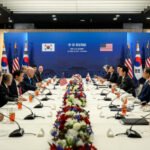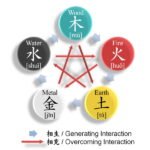Introduction to Sejong: A Background of Greatness
King Sejong the Great, widely regarded as one of the most influential monarchs in Korean history, was born on May 7, 1397, as the third son of King Taejong of Joseon. His early years were characterized by a rigorous education that laid the foundation for his future accomplishments. Sejong was not only well-versed in Confucian teachings, which were critical to governance during the Joseon dynasty, but he also developed a keen interest in science, literature, and the arts. This diverse educational background would play a pivotal role in shaping his progressive vision for Korea.
Ascending to the throne in 1418, Sejong faced a nation in the midst of social and political challenges. The Joseon dynasty was marked by a reliance on a rigid class system, creating disparities among the populace. Recognizing the need for reform, Sejong aimed to establish a more equitable society. His rule began in an atmosphere filled with both optimism and adversity, requiring thoughtful leadership to unify the kingdom and promote the welfare of his subjects.
Sejong is most renowned for his contribution to the Korean language through the creation of Hangul, a writing system that made literacy accessible to the common people. Before Hangul, the elite class predominantly used Classical Chinese, leaving the lower classes largely uneducated. By introducing a phonetic alphabet in 1446, Sejong revolutionized communication and education, fundamentally altering the cultural landscape of Korea. His initiatives also spanned advancements in agriculture, astronomy, and technological innovation, positioning Korea as a leader in East Asia during his reign.
Thus, the background and early life of King Sejong not only highlight his extraordinary capabilities but also set the stage for the transformative changes he would implement. His enduring legacy continues to influence Korea, as the ideals of education, progress, and inclusivity remain integral to the nation’s identity.
The Birth of Hangul: A Revolutionary Script
One of the most notable achievements of King Sejong the Great was the creation of Hangul, the unique script that would revolutionize literacy in Korea. Before Hangul was introduced in the 15th century, the Korean people primarily used Classical Chinese characters, which posed significant challenges for the general populace. The complexity of these characters made reading and writing an arduous task for many, particularly for those who were illiterate or belonged to lower socioeconomic strata. This situation hindered communication and stifled access to knowledge.
Sejong recognized that effective governance required an informed citizenry. His vision for a more literate society was driven by the belief that all people, regardless of social status, should have access to their language. To achieve this goal, he initiated the design of a simpler and more intuitive writing system that could be easily learned and used by commoners. In 1443, he assembled a group of scholars to develop Hangul, which was officially promulgated in 1446 through the publication of “Hunminjeongeum,” meaning “the correct sounds for the instruction of the people.” This text not only explained the script but also underscored the rationale behind its creation: enabling the masses to attain literacy.
Initially, Hangul faced skepticism and resistance from the Confucian elite, who preferred the established Chinese characters, viewing Hangul as inferior. However, over time, its practicality and user-friendliness won over the hearts of the Korean populace. Hangul facilitated widespread literacy, empowering individuals to engage with the written word in their own language, enhancing education and communication across society. The long-term impact of Hangul on Korean culture and identity cannot be overstated, as it laid the foundation for a uniquely Korean literary tradition that continues to thrive today.
Sejong’s Support for Science and Technology
Sejong the Great, the fourth king of the Joseon Dynasty, is widely recognized for his groundbreaking contributions to the fields of science and technology. His reign, spanning from 1418 to 1450, was marked by a commitment to fostering intellectual growth and innovation, which ultimately transformed the socio-economic fabric of Korea. Central to his vision was the establishment of various scientific institutions, including the Hall of Worthies, known as the Jiphyeonjeon. This institution facilitated research and development, empowering scholars to engage in scientific inquiries that would benefit the nation.
Among the various technological advancements that took root during Sejong’s rule, a notable example is the invention of rain gauges and water clocks. These inventions were pivotal in aiding agricultural practices, directly enhancing crop yields and ensuring food security for the population. By introducing more accurate methods for measuring rainfall and time, Sejong made significant strides in agricultural planning, which was vital given Korea’s agrarian economy. This practical application of science exemplifies how Sejong leveraged technology to improve public welfare.
Scholars such as Jang Yeong-sil played an instrumental role in the implementation of Sejong’s vision for scientific advancement. Jang, renowned for his innovative spirit, developed numerous devices and tools that reflected Sejong’s progressive stance on science. His work extended beyond mere inventions; it encompassed creating instruments suitable for measuring astronomical phenomena, which further placed Korea on the map of global scientific discourse during the period.
In promoting these advancements, Sejong not only prioritized technologies that would yield immediate benefits but also understood the long-term significance of scientific knowledge in shaping society. This comprehensive approach to science and technology led to a period of enlightenment in Korea, characterized by a flourishing of intellectual pursuits and practical innovations.
Cultural Flourishing Under Sejong’s Reign
During the reign of Sejong the Great, Korea experienced an exceptional cultural flourishing that left a lasting impact on its society and heritage. This period saw significant advancements in literature, art, and music, largely propelled by the king’s policies that emphasized the importance of education and creative expression. Sejong’s commitment to the cultural development of Korea led to the establishment of various institutions dedicated to fostering the arts and literature.
One of the most remarkable achievements of this era was the promotion of the Korean script, Hangul, which was created under Sejong’s guidance. This innovation played a crucial role in making reading and writing accessible to the common people, thereby nurturing a widespread literary culture. As a result, a plethora of literary works emerged, reflecting the sentiments and experiences of the time. Notable scholars and poets flourished, producing poetry, prose, and historical texts that contributed to a rich literary canon.
Moreover, Sejong’s reign was marked by a vibrant artistic movement. The king actively patronized artists and craftsmen, resulting in the creation of numerous paintings, ceramics, and crafts. Traditional Korean painting styles began to emerge, showcasing the beauty of nature and everyday life, while also illustrating Confucian ideals that were integral to the era’s philosophy.
The musical landscape also transformed during Sejong’s rule, with the development of new musical instruments and genres. The royal court became a center for musical innovation, where traditional Korean melodies harmonized with new influences. This synthesis of styles not only enriched the cultural tapestry but also laid the groundwork for future musical trends in Korea.
In essence, Sejong the Great’s reign epitomized a cultural renaissance that permeated various facets of Korean life, shaping the identity of the nation for generations to come. By fostering an environment ripe for artistic and intellectual growth, Sejong established a legacy that continues to resonate in Korea’s culture today.
Sejong’s Diplomacy and Military Strategy
King Sejong the Great, who reigned from 1418 to 1450, was not only a remarkable reformer of Korean society but also a skilled diplomat and military strategist. His approach to foreign relations was characterized by a delicate balance between proactive diplomacy and military preparedness, particularly in relation to threats from Japan and the Jurchens. This multifaceted strategy allowed him to navigate a complex political landscape effectively.
Sejong understood the importance of fostering peaceful relations while simultaneously ensuring that Korea was adequately defended against external threats. His diplomatic initiatives included negotiating treaties and establishing communication channels with neighboring states, thereby reducing the likelihood of conflict. For instance, Sejong’s engagement with the Jurchens was aimed at stabilizing the northern borders of Korea. By promoting trade and cultural exchanges, he sought to foster goodwill, which ultimately contributed to regional stability.
However, Sejong did not shy away from military readiness when necessary. The Korean military was restructured to improve efficiency and effectiveness, ensuring that troops were well-equipped to respond to any potential aggressions. During his reign, Sejong oversaw significant battles, such as the campaigns against Japanese pirates, which were prevalent during that period. These encounters not only demonstrated Korea’s military prowess but also emphasized the necessity of maintaining sovereignty over its coastal territories.
Furthermore, treaties like the “Treaty of Jinheung” exemplified Sejong’s commitment to leveraging diplomatic means to achieve peace. Such agreements were crucial, as they facilitated dialogue and ultimately led to periods of relative tranquility. Sejong’s ability to blend diplomacy with military strategy served to secure Korea’s interests, laying a foundation for stability that would endure long after his reign. His legacy in foreign relations set a precedent that would influence subsequent Korean leaders in their dealings with neighboring states.
The Legacy of Sejong: Influence on Future Generations
The legacy of King Sejong the Great is deeply embedded in the cultural and social fabric of Korea, marking an era of enlightenment and transformation in various aspects of life. One of the most significant contributions of Sejong was the creation of Hangul, the Korean alphabet, which revolutionized literacy rates across the nation. Prior to Hangul, the majority of Koreans relied on Classical Chinese for written communication, a complex system that limited accessibility to education and literate society. By developing a phonetic alphabet tailor-made for the Korean language, Sejong enabled a greater portion of the population to engage with written discourse. This democratization of literacy not only empowered individuals but also fostered a culture-oriented towards learning and knowledge, setting a foundation for future generations.
Sejong’s commitment to scientific advancements had a profound influence on Korea’s development. Under his reign, significant inventions such as the rain gauge and the water clock were developed, reflecting a monarch who prioritized practical knowledge for the improvement of agricultural practices and daily life. This spirit of inquiry and innovation continued to inspire future scholars and researchers, contributing to a historical legacy that demonstrates the importance of education and science in national advancement. Moreover, Sejong’s encouragement of scholarly pursuits laid the groundwork for later developments in various academic fields, including mathematics, astronomy, and medicine.
The cultural developments initiated during Sejong’s reign also left a lasting impact on Korea’s national identity. The promotion of Korean art, music, and literature created a sense of unity and pride that resonated throughout the ages. This artistic renaissance not only celebrated Korea’s unique heritage but also cultivated a distinct cultural identity, which remains influential to this day. In conclusion, the transformative contributions of Sejong the Great continue to echo through modern Korea, illustrating his role as a visionary monarch who shaped the nation’s identity and future trajectory.
Sejong in Popular Culture: Myths and Representations
Sejong the Great, regarded as one of Korea’s most influential monarchs, has left an indelible mark not only on history but also on popular culture. His life and accomplishments have been depicted in various forms, including literature, films, and television dramas, each contributing to an evolving narrative that intertwines fact and myth. These portrayals often emphasize his role in the creation of Hangul, the Korean alphabet, portraying him as a wise and benevolent ruler dedicated to his people’s welfare. However, while these representations celebrate his achievements, they sometimes create myths that oversimplify the complexities of his reign.
In literature, Sejong has been depicted as a near-mythical figure, embodying the ideals of wisdom and justice. These narratives often highlight his scholarly pursuits and innovative reforms, presenting him as a visionary leader. Works of historical fiction sometimes exaggerate his character, presenting him as an almost superhero-like figure who overcame numerous obstacles through sheer brilliance and moral integrity. Such representations not only romanticize his legacy but also shape the public’s understanding of his contributions to Korean history.
Television dramas and films have further popularized Sejong’s image, often dramatizing key events during his reign. These formats tend to emphasize personal rivalries, court intrigues, and the balance of power, providing a more engaging narrative for the audience. This dramatization can lead to the creation of myths surrounding Sejong’s relationships and decisions, portraying him in ways that prioritize entertainment over historical accuracy.
The impact of these cultural representations is profound, influencing contemporary society’s perception of Sejong. As a result, he is often admired not merely for his accomplishments but as a symbol of national pride and identity, embodying the virtues and aspirations of the Korean people. Through these artistic expressions, Sejong the Great remains a pivotal figure in the collective memory of Korea, continuously inspiring new generations.
Reflections on Leadership: Lessons from Sejong the Great
Sejong the Great, the fourth king of the Joseon Dynasty, is revered not only for his significant contributions to the cultural and intellectual landscape of Korea but also for his remarkable leadership qualities. His reign, which spanned from 1418 to 1450, exemplifies a strong vision, dedication to the welfare of the populace, and a commitment to progress that modern leaders can learn from. Sejong’s innovations, particularly in the development of the Korean alphabet Hangul, underscore his foresight and understanding of the importance of accessibility in communication.
One of Sejong’s defining attributes as a leader was his visionary outlook. He recognized the potential for an educated society and sought to eliminate barriers to literacy. By implementing Hangul, he empowered common people, allowing them to read and write in their native tongue. This not only fostered a sense of identity but also spurred technological and philosophical advancements. Modern leaders can draw parallels from this aspect of his reign, understanding that inclusivity can drive societal progress and ultimately enhance collective growth.
In addition to his visionary prowess, Sejong demonstrated profound compassion for his people. His administration actively sought out their needs through various initiatives, including legal reform and agricultural improvements. He placed great emphasis on understanding the challenges faced by his subjects and implemented policies that addressed these concerns. Today’s leaders must similarly embrace empathy in their governance, recognizing that sustained engagement with their constituents can lead to more effective and holistic decision-making.
Sejong’s commitment to progress was unwavering. He established institutions dedicated to scientific research and innovation, thereby laying the groundwork for future advancements. His leadership serves as a reminder that a focus on continuous improvement is essential for any successful administration. By prioritizing knowledge, compassion, and visionary thinking, modern leaders can foster environments that promote advancement and elevate the communities they serve.
Conclusion: The Enduring Impact of Sejong the Great
Sejong the Great, the fourth king of the Joseon Dynasty, is undeniably a monumental figure in Korean history. His reign, marked by significant cultural and technological advancements, laid a foundation that would shape Korean society for generations to come. The innovative implementation of the Korean script, known as Hangul, stands out as one of his most transformative contributions, enabling literacy and communication among the common people. This linguistic reform not only fostered a sense of national identity but also democratized access to knowledge, which was previously confined to the elite who spoke classical Chinese.
Beyond linguistic innovations, Sejong’s commitment to scientific exploration and agricultural improvement had far-reaching implications. The development of various scientific instruments and calendars helped align Korean agriculture with seasonal needs, optimizing productivity and fostering food security. His reign also saw the promotion of Confucian ideals, elevating education and ethical governance — concepts that continue to resonate within the fabric of contemporary Korean society.
The legacy of Sejong the Great endures as a vital part of Korea’s historical narrative. His story is not merely one of past achievements; it is a lens through which one can understand the evolution of Korea’s cultural and intellectual landscape. Modern Koreans still celebrate his contributions, viewing him as an emblem of national pride and intellectualism. In the context of global history, Sejong’s innovations serve as a testament to the potential of enlightened leadership and its capacity to uplift society.
Ultimately, the impact of Sejong the Great transcends his time, offering valuable lessons in governance, education, and the importance of cultural identity. His enduring influence continues to inspire not only historians and scholars but also policymakers and leaders in today’s ever-changing world.















